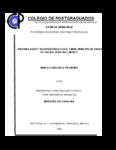Sistemas agro y silvopastoriles en El Limón, municipio de Paso de Ovejas, Veracruz, México
Abstract
La caracterización de los sistemas agroforestales es una buena herramienta que en su momento proporciona elementos de análisis para la toma de decisiones en sistemas de uso del suelo. El objetivo de la investigación fue caracterizar los sistemas agroforestales de acuerdo a sus componentes (agrícola, forestal y pecuario) y al principal uso de las especies arbóreas en la comunidad El Limón, municipio de Paso de Ovejas, Veracruz. Además evaluar la producción de biomasa vegetal y composición química anual y por época (nortes, seca y lluvia) de los sistemas privilegio (Panicum maximum Jacq.) solo o asociado a guácimo (Guazuma ulmifolia Lam.) o a cocuite (Gliricidia sepium (Jacq.) Kunth ex Walp.), bajo manejo dirigido (DR) o tradicional (TR), en un año. Se seleccionaron 24 agroecosistemas (AES) con ganadería donde se realizaron recorridos de campo y aplicaron entrevistas semiestructuradas a productores. Se identificaron un total 106 sitios de los cuales 78 se clasificaron como sistemas silvopastoriles, 26 en sistemas agrosilvopastoriles y dos fracciones de vegetación secundaria (acahual); de todos los sitios, en el 59% el componente forestal tuvo la función principal de proporcionar leña, 16.2% sombra, 11.4% forraje, 5.7% postes, 6.7% cercas vivas y 1% frutal. 70 especies arbóreas fueron identificadas. La producción de biomasa anual bajo manejo DR y TR fue 8,049.3 ±5 85.5 y 4169.5 ± 318.5 kg MS ha-1 en el sistema privilegio-guácimo, 7,122.6 ± 94.0 y 876.5 ± 12.6 en privilegio-cocuite, respectivamente, y 5,262.8±54 en el sistema privilegio solo, bajo manejo tradicional. Esta producción fue alta en la época de lluvias (5233.6 ± 56.66 kg MS ha-1) en todos los sistemas y formas de manejo, disminuyó en la época de nortes (2342.3 ± 27.0) y casi se detuvo durante la época seca (252.9 ± 2.0). De los tres sistemas evaluados, el sistema privilegio-guácimo presentó el mayor valor anual y por época de proteína cruda (21.8% y 23.1, época de nortes, respectivamente) y el menor contenido de fibra detergente neutro (55.2 y 55.2% época de lluvia, respectivamente). Se concluye que el sistema más común en estos agroecosistemas es el sistema silvopastoril el cual está integrado por bovinos, privilegio y árboles de distintas especies dispersas, mientras que los agrosilvopastoriles están compuestos de maíz, bovinos y especies arbóreas en cercas vivas. Además, la producción que biomasa aérea, composición morfológica y química de P. maximum solo o asociado a G. ulmifolia y G. sepium, puede mejorarse modificando los patrones tradicionales de pastoreo, e implementando un sistema de periodos de descanso y ocupación como en el sistema de pastoreo rotacional.________Characterizing agroforestry systems helps provide valuable information for decisions regarding land use. The objective of this research was to characterize the agroforestry systems in the community of El Limon, Paso de Ovejas, Veracruz, according to the presence of crops, livestock, trees, and the principle use of tree species. Annual and seasonal (windy, dry and rainy) biomass production and chemical composition of Panicum maximum Jacq. alone and in association with Guazuma ulmifolia Lam. or Gliricidia sepium (Jacq.) (Kunth ex Walp.) under traditional and improved grazing management over a year were quantified. Twenty-four agroecosystems containing livestock and farmers were included in the study, and farmers were interviewed using a semi-structured questionnaire, and field observations were performed. One hundred and six sites were identified, from which 78 were classified as silvopastoral systems, 26 as agrosilvopastoral systems, and two as sustained secondary succession vegetation. A total of 70 tree species were observed across all sites, and in 59% of the sites trees were primarily used for firewood, in 16.2% of the sites for shade, in 11.4% of the sites as forage, in 5.7% of the sites for fencing, in 6.7% of the sites as live fences, and in 1% of the sites as fruit production. Annual biomass production using improved or traditional methods was 8,049.3 ± 585.5 and 4169.5 ± 318.5 kg DM ha-1 in P. maximum-G. ulmifolia, 7,122.6 ± 94.0 and 876.5 ± 12.6 in P. maximum-G. sepium, and 5,262.8 ± 54 in P. maximum (only using traditional methods). Biomass was higher in the rainy season across all systems and grazing management (5233.6 ± 56.66 kg DM ha-1), decreased during the windy season, and almost ceased during the dry season (252.9 ± 2.0). Forage from the P. maximum-G. ulmifolia system had the highest annual (21.8%) and seasonal (23.1%, windy season) protein content and the lowest amount of neutral detergent fiber (55.2 annual and 55.2% during the rainy season). The silvopastoral is the most popular agroforestry system in the studied area, integrating cattle, P. maximum and different dispersed tree species; followed by the agrosilvopastoral system composed of corn, cattle, and different tree species used in most cases as living fences. Total above-ground vegetation biomass, components of this variable measured as the proportion of biomass present as leaves, stems, and dead matter, and the chemical composition of P. maximum alone or associated with G. ulmifolia and G. sepium, can be improved by modifying traditional grazing management to encompass more regular occupation and resting periods as it is in a rotational grazing system.
Collections
- Tesis MC, MT, MP y DC [227]

